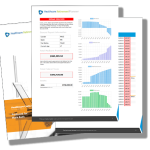Picture this: you’re about to step into the golden years of your life, and uncertainty looms. Retirement is knocking on your door but are you ready? Most people aren’t. They rely heavily on traditional retirement plans that may not be enough.
IUL Retirement, a term known by few but understood by fewer, could be the knight in shining armor for many seeking financial security during their sunset years. It’s an intriguing concept where life insurance meets investment – a seemingly unconventional approach with significant potential benefits.
This isn’t just another piece waxing lyrical about financial planning or abstract concepts. We dive deep into IULs – indexed universal life policies – dissecting them piece-by-piece from its unique tax advantages to potential pitfalls; all wrapped up in simple, practical language anyone can grasp.
Here’s a spicy bit: we also draw comparisons.
Understanding the Concept of IUL Retirement
Indexed Universal Life (IUL) Retirement can be a powerful tool in your financial planning toolkit. Unlike traditional Life Insurance policies, an IUL policy offers more than just a death benefit.
An IUL plan is linked to market indexes like Dow Jones indices. When the index goes up, your policy earns interest but if it drops, you don’t lose money.
This kind of setup makes for an appealing savings plan option during retirement years. It allows individuals to build wealth and provides protection against market downturns with no risk of losing their principal investment because they’re not directly invested in the stock market.
Basics of Indexed Universal Life Insurance
The basic idea behind an Indexed Universal Life insurance policy (IUL) is simple – it’s designed as both a life insurance coverage and an investment account that builds cash value over time.
A part of each premium paid into these types of policies gets allocated towards potential growth linked to major stock indexes like Dow Jones Indices while ensuring capital preservation even when markets are down.
- You have control over where premiums get allocated which can range from fixed accounts offering guaranteed returns or equity-indexed accounts that offer potentially higher returns tied to performance metrics like S&P 500 or Nasdaq Composite Index.
- The death benefit component gives peace-of-mind knowing loved ones will receive beneficiaries tax-free funds upon one’s passing.
- Last but not least; any gain within this type policy isn’t subject to taxes when withdrawn so any money taken will not count towards Medicare’s IRMAA or the taxation of your Social Security benefits.
IUL can be an effective way of counterbalancing taxation on retirement savings, offering the prospect of tax-exempt income in one’s later years.
Key Takeaway:
An IUL retirement plan offers more than just life insurance – it’s also a savings tool that builds cash value, linked to market indexes. This setup lets you grow wealth and safeguards against market downturns without risking your principal investment. Plus, gains within this policy aren’t taxed until withdrawn, making for potentially tax-free income during retirement.
Pros and Cons of IUL as a Retirement Plan
The concept of using an Indexed Universal Life (IUL) insurance policy for retirement savings can be intriguing. It combines the security offered by life insurance with the potential for growth linked to stock market performance. However, it is important to consider the potential advantages and drawbacks of this strategy.
Benefits of Using IUL for Retirement Savings
An IUL policy offers unique benefits that make it attractive in the realm of retirement planning. For starters, the cash value portion grows tax-deferred; this means you don’t pay taxes on gains until you withdraw them during your golden years.
Ideal scenarios suggest high returns tied to Dow Jones Indices or similar indexes while protecting against losses when markets decline.
Besides offering a death benefit component that pays out beneficiaries tax-free, policies also provide flexibility around premium payments which traditional investment accounts may not offer.
Drawbacks and Risks Associated with IUL Policies
However tempting the perks seem, one must remember every coin has two sides – so does an IUL plan. Let’s dive into some potential pitfalls here. First off: cost – premiums paid towards such plans are typically higher than other types of life insurance coverage due to their added features.
If funds aren’t managed properly, there is a risk attached to ‘policy lapse’ leading to significant loss, including both contributions made over time and death benefits initially promised. Advisory firms often stress careful management.
Last but not least, while the policy earns returns linked to market indices like Dow Jones, there is often a cap on potential earnings limiting upside growth. So while it provides some protection against losses, it also restricts your gains during strong bull markets.
Key Takeaway:
An Indexed Universal Life (IUL) insurance policy can be a compelling tool for retirement savings, merging life insurance security with growth potential tied to the stock market. It’s alluring due to tax-deferred cash value growth and flexibility around premium payments. But beware. Higher premiums, risk of ‘policy lapse’, and capped earnings are significant drawbacks you need to consider.
Table of Contents:
- Understanding the Concept of IUL Retirement
- Pros and Cons of IUL as a Retirement Plan
- Tax Implications Involved in IUL Retirement
- IUL Retirement vs. Traditional 401(k) Plans
- Wealth Building Strategies with IUL Retirement
- Ensuring Financial Security with IUL Retirement Strategies
- IUL Retirement and its Efficiency in Tax Planning
- Considerations and Tips for Planning IUL Retirement
- FAQs in Relation to Iul Retirement
- Conclusion
Tax Implications Involved in IUL Retirement
Understanding the tax implications of an Indexed Universal Life (IUL) retirement plan is essential for smart financial planning. Taxes can have a significant effect on the amount of savings you will be able to access when it comes time for retirement, so understanding how they apply to your IUL plan is important.
An appealing feature of IUL policies is their tax-advantaged growth. With this, any increase in the cash value portion isn’t subject to capital gains tax, unlike other investment accounts. So if your policy earns interest from being tied up with a Dow Jones index or similar indices, you don’t pay capital gains tax on that return credited.
This also applies during distributions. You can take out loans against your policy’s cash value without triggering income tax consequences, Medicare’s IRMAA or even the taxation of your Social Security benefits as well.
However, keep in mind that these benefits only remain if the policy stays intact until death. If the insurance plan lapses or gets surrendered before then because premiums aren’t paid consistently, it may lead to some hefty ordinary income taxes on any gain over what was contributed into the life insurance coverage.
The concept here works similarly like student loans and credit cards: miss payments and face penalties; except here instead of late fees we are talking about losing substantial amounts through unnecessary taxation.
Death Benefit Component & Taxation
A major highlight comes at death where beneficiaries receive death benefits completely free from federal income tax as per IRC Section 101(a). This rule applies not just for IULs but generally all types of life insurances be it term life or permanent life.
Given these tax implications, IULs can be a potent tool for retirement planning and personal finance. It is recommended to consult with a professional financial advisor or CFP to comprehend how an IUL can be incorporated into one’s comprehensive fiscal plan.
Key Takeaway:
Getting a grip on the tax aspects of IUL retirement plans is crucial for savvy financial decisions. These policies’ growth reaps tax perks, and you can even borrow against your policy’s cash value sans income taxes. But watch out – if premiums aren’t regularly paid, it could lead to big ordinary income taxes. Plus, death benefits from IULs are totally exempt from
IUL Retirement vs. Traditional 401(k) Plans
Choosing between an Indexed Universal Life (IUL) retirement plan and a Traditional 401(k) requires understanding their differences in investment options, tax benefits, and potential returns.
Investment Options in IUL and 401(k)
An IUL insurance policy, linked to stock market indices like the Dow Jones Indices, provides more flexible investment options compared to a traditional 401(k). The cash portion of your premium gets allocated towards either a fixed account or one tied to various equity index performances such as the S&P500.
In contrast, typical employer-sponsored 401(k)s limit you to select mutual funds they offer. Your capital gains depend on these chosen investments’ performance over time.
Tax Benefits Comparison
The tax implications differ significantly between both plans too. With an IUL plan, growth is tax-deferred meaning that earnings are not taxed until withdrawal occurs. But here’s the catch – if structured correctly with loans against it taken out instead of direct withdrawals during retirement years, this income can be received entirely free from taxes.
A conventional 401(K), however, offers immediate ordinary income tax deductions for contributions but slaps taxes upon distributions at standard rates similar to wage-based incomes once retired. Early withdrawal before age 59½ may also incur penalties plus additional taxes unless certain exceptions apply.
Also, as withdrawals from any Traditional 401(k) count as ordinary income you may be subject to both your Social Security benefit being taxed as well as Medicare’s IRMAA.
With an IUL any money taken as a loan will never impact either your Social Security benefit or your Medicare premiums.
Potential Returns: Volatility vs Consistency
If we compare risk versus return trade-offs; while IULs offer protection against negative market downturns, they cap the upside return credited to your account during boom years. This offers more stability and less anxiety about market volatility but potentially smaller gains.
401(k)s on the other hand allow for unlimited growth potential, which could lead to larger capital accumulation over time if markets perform well. But there’s also an inherent risk of losses in case of poor market performance.
Key Takeaway:
Deciding whether to go for an IUL retirement plan or a Traditional 401(k) really depends on what you’re looking for. If flexible investments that are linked to market indices and unique tax perks (if set up right), appeal to you, then IULs could be your thing. They offer stability in volatile markets but the gains have a ceiling. On the flip side, 401(k)s might restrict your investment options but they give instant tax breaks.
Wealth Building Strategies with IUL Retirement
Indexed Universal Life (IUL) insurance isn’t just a safeguard for your loved ones. It’s also an ingenious way to build wealth for retirement. An IUL retirement plan lets you save money, grow it tax-free, and access it without the usual penalties.
Ideal Asset Allocation in Your IUL Plan
The cash portion of your policy earns interest based on the performance of certain indexes like Dow Jones Indices. But unlike direct investment in the stock market, there’s no risk of losing principal due to poor index performance because gains are capped at a minimum return credited rate.
Consider having an asset allocation that aligns with your risk appetite for optimal results. A conservative investor might choose more stable indices while those who can tolerate higher risks may opt for more volatile options.
Growing Wealth Through Tax-Free Policy Loans
A unique feature about IUL plans is that they allow early withdrawal through loans against the cash value built up within them without any tax implications – something not possible with traditional 401(k)s or IRAs where required minimum distributions often trigger taxes.
This makes sense if you think about how student loans work – borrowing from yourself instead of from banks or credit cards saves both interest payments and future headaches.
Making Use Of Death Benefit Component As Safety Net
Your death benefit component acts as a safety net providing beneficiaries tax-free payouts when life throws curveballs their way – making these policies attractive parts of comprehensive financial plans designed by certified financial planners across America today.
Ensuring Financial Security with IUL Retirement Strategies
The path to a secure retirement can be complex, but an Indexed Universal Life (IUL) insurance plan offers unique strategies. These plans blend the benefits of life insurance coverage and potential for growth in cash value linked to a market index like Dow Jones Indices.
An IUL policy’s key component is its dual nature: death benefit and cash portion. The death benefit component provides security for your beneficiaries tax-free upon your passing. But what makes it more than just an ordinary life insurance plan is the indexed aspect.
Growing Your Wealth through Market Performance
Your premiums paid into the policy are split between securing a death benefit and investing in an indexed account tied to market performance, such as Dow Jones or other indices. When these indexes perform well, so does your investment account.
You’re not directly invested in any stocks or mutual funds; instead, you earn returns based on changes in that index without risking losing money if markets decline – thanks to minimum return credited by most policies. This allows you to build wealth over time while minimizing risk exposure associated with variable universal life options.
Avoiding Unnecessary Tax Implications
IUL retirement strategies offer significant tax advantages too. Any gains within the policy aren’t subject to capital gains taxes unlike traditional investment accounts would be exposed during withdrawals.
When used strategically for loans against accumulated cash values – those amounts generally won’t attract ordinary income tax either which differentiates it from early withdrawal penalties faced by 401(k)s or IRAs requiring required minimum distributions after certain age.
Understanding how much could potentially save on taxes can be an eye-opener.
As always, every individual’s financial plan and circumstances are unique. It’s advisable to consult with a certified financial planner or trusted advisory firm to make sure that IUL retirement strategies align well with your long-term goals and risk tolerance.
Key Takeaway:
An Indexed Universal Life (IUL) insurance plan gives you the chance to secure your retirement and grow wealth, linking cash value growth to market indices like Dow Jones. This unique blend of life coverage and investment strategy minimizes risk exposure while promising potential returns.
Plus, IUL plans are a great way to sidestep capital gains taxes on policy profits and they let you take out loans tax-free.
IUL Retirement and its Efficiency in Tax Planning
When it comes to retirement tax-planning, an Indexed Universal Life (IUL) insurance plan could be a major advantage. It’s not just about the death benefits but also the potential to grow your wealth tax-efficiently.
An IUL policy earns interest based on market performance indices like Dow Jones. However, what sets this apart is that you don’t directly invest in these indices. Instead, your returns are credited based on their movement.
The cash portion of an IUL accumulates over time without any immediate tax implications. This means more money stays invested and grows faster than if it were subjected to taxes each year – similar to a traditional investment account or mutual funds but with greater flexibility.
Using Your IUL as a Savings Plan
A strategic approach involves using part of your policy’s cash value as a supplementary income stream during retirement – akin to how one would use distributions from other savings plans or investments accounts. This strategy, when used right, can provide substantial financial support while keeping taxable income at bay because withdrawals up till the amount of premiums paid aren’t subject to ordinary income tax.
This efficient ‘tax play’ might remind you of Roth IRAs where qualified distributions come out free from federal taxes. The difference here lies in no limitations being imposed by early withdrawal penalties or required minimum distributions rules; giving much-needed liquidity freedom.
Navigating Potential Risks
However fascinating these perks may seem, there are certain risks associated with choosing an IUL for retirement planning. For instance: You must make sure that enough premium is paid to prevent a policy lapse. If your IUL policy does lapse, the unpaid loans become taxable.
Although returns may be linked to market indices such as the Dow Jones Indices, they are typically limited in their growth potential and may not equal actual index gains.
The key lies in understanding these dynamics and working closely with an advisory firm or certified financial planner who can guide you through this complex landscape. Remember: A well-planned strategy always pays off.
Key Takeaway:
An Indexed Universal Life (IUL) insurance policy can be a real difference-maker for smart, tax-friendly retirement planning, letting your money pile up quicker. Tapping into a slice of your policy’s cash value as an extra income source in retirement delivers solid financial backing while keeping taxable income low. But don’t forget, there’s no such thing as risk-free: you’ve got to shell out enough premium to keep the policy from falling through.
Considerations and Tips for Planning IUL Retirement
The process of planning an Indexed Universal Life (IUL) retirement involves careful thought. Evaluate the risks and possible rewards when making any monetary decisions.
Assess Your Financial Goals and Risk Tolerance
To start off, assess your long-term financial goals. An advisory firm can help guide this discussion if needed. Consider factors like when you plan to retire, how much income you’ll need in retirement, and what level of risk is acceptable for your investments.
This assessment should also include a thorough review of other elements such as student loans or credit cards debt that might impact your overall personal finance situation.
Evaluate Different Insurance Plans
In addition to indexed universal life insurance policies, it’s crucial to evaluate all available options including term life insurance or permanent life coverage before making a decision on which route suits best for your needs.
A certified financial planner could provide more detailed insight here – but remember that ultimately the choice lies with you because every individual has unique circumstances.
Diversify Your Investment Account
An IUL policy shouldn’t be seen as the sole means of building wealth during retirement years but rather part of a diversified portfolio. A mix may include mutual funds along with savings plans specifically tailored towards capital gains tax advantages; these considerations can add layers upon an already complex investment landscape requiring keen understanding around tax implications among others things so consider consulting professionals where necessary.
Beware Of Policy Lapse
Paying premiums timely ensures maintaining death benefit component intact besides enabling cash portion growth too. Remember though – non-payment could lead to policy lapse which might leave you without coverage at a crucial time.
Plan for Tax Efficiency
IUL policies can provide tax-free death benefits, making them an efficient tool in retirement planning. Calculate Your Capital Gains Tax to get more clarity on this aspect.
Let’s continue.
Key Takeaway:
When planning an IUL retirement, consider your long-term financial goals and risk tolerance. Review all insurance plans available to find the best fit for you. Diversify your investments; don’t rely solely on IUL policies. Be vigilant about paying premiums to avoid policy lapse, and plan for tax efficiency by calculating capital gains tax.
FAQs in Relation to Iul Retirement
Is an IUL a good retirement plan?
An IUL can be a solid choice for those who want potential market-linked growth and tax advantages. But, like all plans, it depends on individual financial goals and risk tolerance.
How does an IUL work for retirement?
IUL works by providing life insurance coverage while also allowing you to build cash value that’s tied to the performance of a stock index. This money can then supplement your income in retirement.
Is an IUL better than a 401k?
IULs offer more flexibility and potential tax benefits compared to 401ks. However, they’re not necessarily “better” – it hinges on your specific needs, financial situation, and long-term goals.
What are the downsides of IUL?
The main drawbacks include high fees, complexity of the product itself and investment risks associated with fluctuating markets. It’s crucial to fully understand these aspects before choosing an IUL as part of your retirement strategy.
Conclusion
Exploring the realm of IUL retirement, you’ve navigated through a financial landscape filled with opportunities and risks. You’ve discovered how indexed universal life policies blend insurance coverage with investment potential.
You now understand both the benefits and drawbacks that come along for this unique ride into your golden years. You’re aware of tax implications tied to an IUL policy and can appreciate its efficiency in planning for future taxation.
IUL retirement isn’t just another term; it’s a strategy designed to secure your sunset years financially. So, weigh all aspects carefully before embarking on this journey towards securing a comfortable retirement.
The tools are there; use them wisely to shape your path towards achieving financial freedom!
Streamlining the Medicare Surcharge Calculation Process.
Our Healthcare Retirement Planner software is designed to streamline the retirement planning process for financial professionals. By providing an efficient way to calculate IRMAA costs, our tool helps you save time and focus on other aspects of your clients’ retirement plans.
- Faster calculations: Our software quickly calculates IRMAA costs based on your client’s income and tax filing status, eliminating manual calculations and potential errors.
- User-friendly interface: The intuitive design of our platform makes it easy for financial professionals to input data and generate results with minimal effort.
- Data integration: Seamlessly integrate our calculator into your existing financial planning tools or CRM systems for a more streamlined workflow.
- Easy to Understand Reports: Export reports to easily share with your clients
- Tax and Surcharge Modeling: see how different types of income affects both taxes and your surcharges.
In addition to simplifying the calculation process, using our Healthcare Retirement Planner can also help improve communication between you and your clients. With clear visuals that illustrate how IRMAA costs impact their overall retirement plan, you can effectively convey complex information in an easily digestible format. This enables clients to make informed decisions about their healthcare expenses during retirement while ensuring they are prepared for any potential changes in Medicare premiums due to income fluctuations. To learn more about how our software can benefit both you as a financial professional and your clients’ retirement planning experience, visit the features page. Streamlining retirement planning processes can help financial professionals save time and resources, allowing them to focus on other areas of their clients’ needs. Automated calculation of IRMAA costs is the next step in streamlining this process even further.







